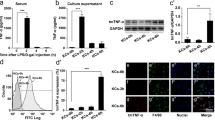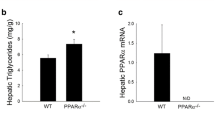Abstract
α1-Acid glycoprotein (AGP) is an acute phase protein produced by hepatocytes. Although its exact biological function remains controversial, it was shown to protect galactosamine-sensitized or normal mice against hepatitis and lethal shock induced by tumor necrosis factor (TNF). Rat-AGP- transgenic mice, constitutively producing several mg AGP per ml serum were tested for their response to a combined challenge with TNF and D-(+)-galactosamine. A previously characterized, single transgenic line (9.5–5) was used. In contrast to our expectations both heterozygous or homozygous transgenic mice were not protected by the endogenously overproduced AGP. However, both transgenic and non-transgenic mice were protected by pretreatment with interleukin-1, an effect which we believe is mediated by the induction of acute phase proteins like AGP. Furthermore, both types of mice were protected by exogenous bovine AGP, suggesting that the lack of protection by endogenous AGP is not because of a repressed response to AGP. Finally, we demonstrate that purified AGP from the serum of transgenic mice is as protective as the AGP from non-transgenic mice or rats. The results suggest that AGP is protective only when its concentration is rapidly induced, perhaps because the endogenous steady state synthesis of AGP, in non-transgenic as well as transgenic mice, is coupled to the production of an AGP-binding factor. This study provides an interesting example of differences in outcome to a lethal challenge between an acute administered and a chronically produced protective protein.
Similar content being viewed by others
References
Baumann, H. (1988) Electrophoretic analysis of acute-phase plasma proteins. Methods Enzymol. 163, 566-94.
Baumann, H. and Gauldie, J. (1994) The acute phase response. Immunol. Today 15, 74-80.
Brouckaert, P.G.G., Leroux-Roels, G.G., Guisez, Y., Tavernier, J. and Fiers, W. (1986) in vivo anti-tumour activity of recombinant human and murine TNF, alone and in combination with murine IFN-gamma, on a syngeneic murine melanoma. Int. J. Cancer 38, 763-69.
Chan, J. and Yu, D. (1991) One-step isolation of α1-acid glycoprotein. Protein Expression Purification 2, 34-6.
Costello, M., Fiedel, B.A. and Gewurz, H. (1979) Inhibition of platelet aggregation by native and desialised alpha-1 acid glycoprotein. Nature 281, 677-78.
Decker, K. and Keppler, D. (1974) Galactosamine hepatitis: key role of the nucleotide deficiency period in the pathogenesis of cell injury and cell death. Rev. Physiol. Biochem. Pharmacol. 71, 77-106.
Dewey, M.J., Rheaume, C., Berger, F.G. and Baumann, H. (1990) Inducible and tissue-specific expression of rat α-1-acid glycoprotein in transgenic mice. J. Immunol. 144, 4392-98.
Eap, C.B. and Baumann, P. (1993) The α1-acid glycoprotein: structure and possible functions in the acute phase response. In Mackiewicz, A., Kushner, I. and Baumann, H. eds., Acute Phase Proteins. Molecular Biology, Biochemistry, and Clinical Applications, pp. 107-16. Boca Raton: CRC Press.
Fiers, W. (1995) Biologic therapy with TNF: preclinical studies. In DeVita Jr., V.T., Hellman, S. and Rosenberg, S.A. eds., Biologic Therapy of Cancer, 2nd ed., pp. 295-327. Philadelphia: J.B. Lippincott.
Fransen, L., Van der Heyden, J., Ruysschaert, R. and Fiers, W. (1986) Recombinant tumor necrosis factor: its effect and its synergism with interferon-γ on a variety of normal and transformed human cell lines. Eur. J. Cancer Clin. Oncol. 22, 419-26.
Kettelhut, I.C., Fiers, W. and Goldberg, A.L. (1987) The toxic effects of tumor necrosis factor in vivo and their prevention by cyclooxygenase inhibitors. Proc. Natl. Acad. Sci. USA 84, 4273-7.
Lainé, E., Couderc, R., Roch-Arveiller, M., Vasson, M.P., Giroud, J.P. and Raichvarg, D. (1990) Modulation of human polymorphonuclear neutrophil functions by α1-acid glycoprotein. Inflammation 14, 1-9.
Lehmann, V., Freudenberg, M.A. and Galanos, C. (1987) Lethal toxicity of lipopolysaccharide and tumor necrosis factor in normal and D-galactosamine-treated mice. J. Exp. Med. 165, 657-63.
Leist, M., Gantner, F., Jilg, S. and Wendel, A. (1995) Activation of the 55 kDa TNF receptor is necessary and sufficient for TNF-induced liver failure, hepatocyte apoptosis, and nitrite release. J. Immunol. 154, 1307-16.
Lejeune, F., Liénard, D., Eggermont, A., Schraffordt Koops, H., Kroon, B., Gérain, J., Rosenkaimer, F. and Schmitz, P. (1994) Clinical experience with high-dose tumor necrosis factor alpha in regional therapy of advanced melanoma. Circ. Shock 43, 191-7.
Libert, C., Van Bladel, S., Brouckaert, P. and Fiers, W. (1991a) The influence of modulating substances on tumor necrosis factor and interleukin-6 levels after injection of murine tumor necrosis factor or lipopolysaccharide in mice. J. Immunother. 10, 227-35.
Libert, C., Van Bladel, S., Brouckaert, P., Shaw, A. and Fiers, W. (1991b) Involvement of the liver, but not of IL-6, in IL-1-induced desensitization to the lethal effects of tumor necrosis factor. J. Immunol. 146, 2625-32.
Libert, C., Brouckaert, P. and Fiers, W. (1994) Protection by α1-acid glycoprotein against tumor necrosis factor-induced lethality. J. Exp. Med. 180, 1571-5.
Libert, C., Van Molle, W., Brouckaert, P. and Fiers, W. (1996a) α1-Antitrypsin inhibits the lethal response to TNF in mice. J. Immunol. 157, 5126-9.
Libert, C., Van Molle, W., Brouckaert, P. and Fiers, W. (1996b) Platelet-activating factor is a mediator in tumor necrosis factor/galactosamine-induced lethality. J. Inflam. 46, 139-43.
Macintyre, S., Samols, D. and Dailey, P. (1994) Two carboxylesterases bind C-reactive protein within the endoplasmic reticulum and regulate its secretion during the acute phase response. J. Biol. Chem. 269, 24496-503.
McNamara, P.J., Brouwer, K.R. and Gillespie, M.N. (1986) Autocoid binding to serum proteins. Interaction of platelet-activating factor (PAF) with human serum alpha-1-acid glycoprotein (AAG). Biochem. Pharmacol. 35, 621-24.
Pevsner, J., Reed, R.R., Feinstein, P.G. and Snyder, S.H. (1988) Molecular cloning of odorant-binding protein: member of a ligand carrier family. Science 241, 336-9.
Schnitzer, J.E. and Pinney, E. (1992) Quantitation of specific binding of orosomucoid to cultured microvascular endothelium: role in capillary permeability. Am. J. Physiol. 263, H48-H55.
Takahashi, N., Brouckaert, P. and Fiers, W. (1991) Induction of tolerance allows separation of lethal and antitumor activities of tumor necrosis factor in mice. Cancer Res. 51, 2366-72.
Van Molle, W., Libert, C., Fiers, W. and Brouckaert, P. (1997) α1-Acid glycoprotein and α1-antitrypsin inhibit TNF-induced but not anti-Fas-induced apoptosis of hepatocytes in mice. J. Immunol. 159, 3555-64.
Author information
Authors and Affiliations
Rights and permissions
About this article
Cite this article
Libert, C., Hochepied, T., Berger, F.G. et al. High-level Constitutive Expression of α1-acid Glycoprotein and Lack of Protection Against Tumor Necrosis Factor-induced Lethal Shock in Transgenic Mice. Transgenic Res 7, 429–435 (1998). https://doi.org/10.1023/A:1008810429645
Issue Date:
DOI: https://doi.org/10.1023/A:1008810429645




